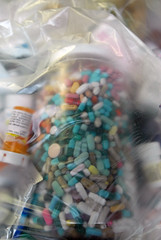(part 2 of 3)
Monitoring the Future released their latest study, noting that alcohol use was down, but marijuana, synthetic marijuana, and prescription drugs were up. In part one of this series, we focused on marijuana and its synthetic counterparts, bringing attention to the
perceived harmlessness of marijuana and the growing trend toward the use of synthetics. Here, we’ll talk about the rampant use of prescription drugs and the myriad dangers which accompany their use.
When it comes to prescription drugs, the ease of acquisition is often as simple as going through a parents’ or relative’s medicine cabinet, raiding a friend’s house, or simply trading with friends at school or at parties. The use of opioid prescriptions like Oxycontin and Vicodin are rampant…and deadly. As reported in Monitoring the Future’s 2010 National Results on Adolescent Drug Use: Overview of Key Findings, “54% of high-school seniors said ‘opioid drugs other than heroin (e.g., Vicodin) would be fairly easy to get.’” Why are teens using prescription drugs with such frequency? Could it simply be the ease with which they’re obtained? Or is it the built-in societal respect for doctors and their judgment which allows us to look away when the pen flies across the prescription pad.
Take note of the behaviors and physical symptoms which surround prescription drug addiction (via Educate Before You Medicate – www.talkaboutrx.org):
Behavioral signs:
- Sudden mood changes:
- Irritability
- Negativity
- Personality change
- Extreme change in friends or hangout locations
- Lying or being deceitful
- Skipping school
- Avoiding eye contact
- Losing interest in personal appearance, extracurricular activities, sports
- Sudden changes in appetite
- Sudden drop in grades and/or academic or athletic involvement
- Borrowing money or having extra, unexplained cash
- Acting especially angry or abusive, or engaging in reckless behavior
Physical Signs and Symptoms (these are varied, depending on the drug being used/abused):
Stimulants can bring about:
- Hyperactivity
- Shaking
- Sweating
- Dilated pupils
- Fast or irregular heartbeat
- Elevated body temperature
- Seizures
- Paranoia/nervousness
- Repetitive behaviors
- Loss of appetite or sudden and unexplained weight loss
Sedatives/depressants can bring about:
- Loss of coordination
- Respiratory depression
- Slowed reflexes
- Slurred speech
- Coma
Opioids can bring about:
- Sleep deprivation or “nodding.”
- Pinpoint/constricted pupils, watery or droopy eyes
- Nausea, vomiting, constipation
- Slow, slurred speech
- Slow gait
- Dry skin, itching, infections
- Constant flu-like symptoms
- Track marks (bruising at injection sites)
The unfortunate, but common misconception is that prescription drug use is safer than illegal drugs like cocaine and heroin: because it’s been prescribed, it’s “okay.” The problem with this ideology is doctors consistently prescribe and sometimes inadvertently over-prescribe narcotics, A: because they work, and B: because it’s easy. What this influx of prescription drugs does, however, is provide an underground stockpile of prescription opioids in the homes of our adolescents and their friends. As patients, start asking for non-narcotic alternatives. It makes no difference to the doctor but it may make the difference of life and death for you or someone in your family.
Start disposing of any unused medications and store those that are necessary in a secured place. Honestly, these days, the medicine cabinet should probably only be used for toothpaste and Tiger Balm.








